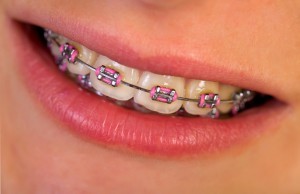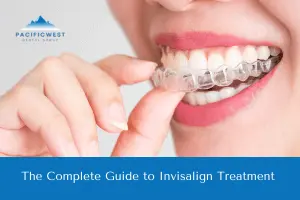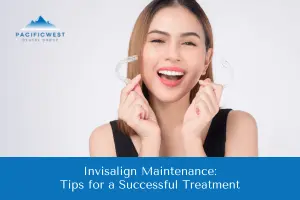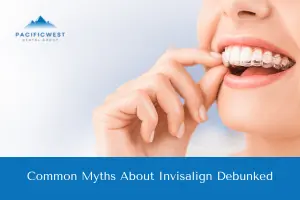Braces aren’t just a brute-force solution to crooked teeth. They work by using the anatomy of the jaw to realign teeth healthily and naturally. The teeth in your mouth are attached to your jawbone by something called a periodontal ligament.
This ligament is made up of collagen, which is the same protein found between your bones, and is used for shock absorption between bones all over your body including your jaw.
Your periodontal ligaments allow some small, natural movement of your teeth (when chewing, for example) while anchoring and suspending the teeth in place. These ligaments join to the root surfaces of your teeth via a connective substance created by your body called cementum.
Key Sections:
- How Do Braces Really Work?
- Do Braces and Invisalign Work Differently?
- Risks and Considerations
- Braces and Your Age
How Do Braces Work?
Braces work by compressing one side of the ligaments on your teeth, while at the same time stretching the ligaments on the other side of your teeth. As the ligaments become compressed, the bone on that side loses blood support and becomes necrotic. The body starts an inflammation process to send in bone-eating cells called osteoclasts to remove the bone; this clears the path and allows the tooth to move in that direction.
The inflammation is what causes the soreness and discomfort in the teeth; it is the most intense in the first few days, then the teeth will start moving and the discomfort will subside. On the other side of the tooth where the ligament is being stretched, bone-creating cells called osteoblasts show up to add new bone around the tooth.
This process is called deposition and it cements the tooth into its new position. This process takes much longer to complete, which is why it is very important to wear a retainer full-time during the process to make sure that teeth do not shift.
This whole process is how your teeth move over time. It’s easy to see how light but consistent forces such as thumb-sucking habits can have big impacts on your bite over the long run!
Why Do We Need a Cast of My Teeth When Getting Braces?
The reason your orthodontist makes a cast, or a digital scan nowadays, of your teeth is for us to have a copy of your teeth so we can spend time studying and analyzing them to come up with the proper diagnosis. After we have identified all the problems, we can then devise the best plan to carefully manipulate forces against your teeth to guide them into new, healthy alignment and bite.
Do Teeth Move Back After Taking Off Braces? Do Effects of Braces Get Reversed?
Once braces are removed, your teeth are no longer held by the braces. Instead, they are held securely in place by the bone under your gums. The reason why most braces take such a long time is that your orthodontist is slowly guiding the teeth to move at a pace as fast as bone turnover can occur.
Once your braces are off, bone starts healing around the tooth to secure them in their new position. This process takes 3-6 months to complete, during which the teeth are still mobile and can shift. For this reason, patients are given a set of removable or fixed retainers to be worn full-time until the bone heals completely.
Afterwards, teeth will still have some natural movements. Even patients who never had orthodontic treatment will experience shifting in their teeth as they age. Therefore, we encourage our patients to still wear their retainers at least 1 or 2 nights per week.
Why Do I Need to Wear a Retainer After Getting Braces?
Oftentimes, your orthodontist may recommend you wear a retainer after getting braces to keep your teeth in the same place.
Most shifting in alignment of teeth (called relapse) will take place immediately after the braces are removed, making the following weeks a time when a retainer should be worn throughout the day to prevent any undesirable shifting. After several months, your orthodontist can evaluate the potential for further movement of the teeth. Should this not be of concern, the retainer may then be worn in the evenings only.
Do Braces and Invisalign Work Differently?
Traditional braces use wires, elastics, and brackets to move your teeth into the desired position. Lingual braces are similar to traditional braces, except the brackets are on the back of your teeth facing your tongue. (So other people cannot see them.) Invisalign involves wearing transparent aligners on your teeth to create minor movements in your teeth.
Although the application is different, all three methods apply constant and gradual force to move your teeth to the desired position gently.
Invisalign moves teeth the same way as braces, by applying force to the teeth in the direction we want the teeth to move towards. However, the application and design of the force is different. Because Invisalign aligners are removable, they rely on friction between the aligner and the tooth surface in its force application. Braces are glued to the tooth, so the brackets become a handle by which we can grab and apply the force.
The force to move the tooth is applied by the wires we use. When a wire is engaged into brackets on teeth that are crooked but adjacent to each other, the displacement of the wire creates tension through the flexing of the wire, and because the wire wants to return to its natural straighter form, it drags the teeth into a straight position.
How teeth are straightened by braces depends on the orthodontist’s skill in placing the brackets in the precise location on the tooth and the adjustments that are done by the orthodontist to the brackets and wires during each appointment when the patients are in the office.
The movements can be very precise because the brackets and wires are FIXED to the tooth, and there is no slippage between the braces and the teeth. This is why the system is called a Fixed appliance, and the technique is called the Straight wire technique.
Invisalign moves teeth by using REMOVABLE aligners. Each aligner differs slightly from the last one. The changes are incremental and are designed on the computer by the orthodontist. All the movements are designed into the system at one time, at the beginning of treatment.
The teeth move due to the slight difference between each stage of the aligner; the slight difference in the aligner and the teeth creates tension, or force, on the teeth, pushing them toward the final form we want them to be. The aligners are forced onto the teeth and are held in place by friction.
Because the aligners are not glued to the teeth, there may be some slippage, causing a slight loss of precision in this system. The imperfection in fit needs to be compensated by over-correcting a particular movement. Therefore, at the end of a series of aligners we may see that a particular goal is not reached with the first set of aligners, we will need to create another set of aligners to compensate for that discrepancy between what is designed and the actual result.
Risks and Considerations
When considering braces, it is important to discuss any potential risks that could be encountered as well as any special considerations worth noting. Here are some of the most commonly asked questions about braces:
Can braces ruin my teeth?
In short: no, if done properly by a dental professional. By consulting with an orthodontist and practicing proper hygiene, it is very unlikely that braces will ruin your teeth. Everyone’s situation is unique – our orthodontists at PacificWest will assess your oral health to ensure braces in Surrey are suitable for you.
1 – The most common issue with wearing braces is tooth decay and gum disease due to poor hygiene. This happens when patients do not spend enough time to thoroughly clean their teeth around the appliance and under the gum. This is why we spent a significant amount of time teaching and coaching patients how to identify dirty teeth and inflamed gums, and how to properly clean them.
2 – The second most common risk is improper treatment planning, resulting in pushing teeth into the wrong position. Even though the teeth may look straight, the wrong position may cause a traumatic bite, or teeth sitting outside of the bone, resulting in poor bone and gum support. This is a potential risk with DIY orthodontics programs that are not supervised by a certified orthodontist.
This is why many patients choose to go to orthodontists for braces in Vancouver, as orthodontics are specialists who focus their practice solely on teeth alignment, bite issues, and the creation of a beautiful and healthy smile. Orthodontists are dentists who receive 2-3 years of additional training and education and have passed the rigorous examination to become certified in the specialty.
Do teeth become weak after braces?
No, with proper treatment planning and maintenance of oral hygiene, your teeth should not be weakened after your braces treatment is complete. Braces will fix your teeth’s alignment. This will correct any bite issues, make it easier to clean your teeth, and improve your overall oral health!
While wearing braces, your teeth will shift, resulting in what feels like looseness of the teeth. The shifting is gradual and the teeth are never in any danger of falling out.
Why Do Wearing Braces Cause Pain and Discomfort?
Unfortunately, the process of correcting teeth through the use of braces does come with some discomfort.
Minor Soreness: Feelings of soreness are a common occurrence reported amongst those who wear braces. Braces exert consistent but gentle force to slowly move teeth into the correct position. As the ligaments around the tooth become compressed, the bone around the tooth loses blood support and becomes necrotic.
The body starts an inflammation process to send in bone-eating cells called osteoclasts to remove the bone; this clears the path and allows the tooth to move in that direction. The inflammation is what causes the soreness and discomfort to the teeth; it is the most intense in the first few days, then the teeth will start moving and the discomfort will subside Typically the pain is mild and can be dealt with painkillers such as Tylenol or even an ice pack.
Poking From Wires: When braces are newly applied, irritation often occurs as the mouth adjusts to the presence of the metal wires and brackets. Our orthodontist will provide orthodontic wax to form a protective shield over the delicate skin inside the mouth. Patients choosing Invisalign would not have this problem.
Difficulty in Chewing: Many patients do report some challenges with both chewing and eating food initially when they first get braces or after each adjustment. This is again due to the inflammation process occurring in the bone around the teeth. However, after a few days, the soreness will go away and chewing will get easier. When your teeth are sore, soft or liquid food is recommended to minimize the need to chew.
Are Braces and Orthodontic Treatments Safe?
Orthodontic treatments are considered to be one of the safest dental treatments in Surrey that a patient can go through. There are no injections, drilling, cutting, or open wounds involved, so there are not many true contraindications in the sense that it would put patients in grave danger if they still receive orthodontic treatment.
There are certain health conditions (such as the ones listed below) that would either make orthodontic treatment more complicated and have less predictable outcomes, or make the teeth or supporting tissue (bones and gum) less healthy during orthodontic treatment.
- Medical conditions that compromise healing, especially bone healing. An example would be patients with significant osteoporosis conditions receiving bisphosphonate treatment. The treatment stops bone turnover by inhibiting osteoclast activity. Without the ability for bone to turnover, tooth movement is limited.
- Patients with active disease in their mouth. This would include caries lesions, periodontal disease, or any other pathology (such as cancer). We need to take care of all infections and pathology inside the mouth and make sure we have a healthy foundation before starting orthodontic treatment.
Braces and Your Age
Though most people typically associate braces with the teenage years, many adults also want to correct their teeth later in life. Among the most commonly asked questions concerning braces and age are:
Can teeth be straightened at any age?
Yes! When it comes to teeth straightening, there is no such thing as an age limit.
The process of your body being able to tolerate the movement of your teeth is the same process of your body being able to heal; such as from a cut or broken bone. As long as there are no underlying medical issues that cause someone to have impairment to their healing process, there is no reason why we would not be able to straighten their teeth with orthodontics.
Many adults decide to finally address tooth problems that have been nagging them through the bulk of their lives by seeking orthodontic treatment.
Orthodontic treatment will improve both the appearance of the smile as well as the future dental health. Problems such as overcrowding or a traumatic bite can lead to tooth decay, gum disease, excess tooth wear, and possible tooth loss. Even if you have lots of fillings or are missing many teeth, it is still beneficial to receive orthodontic treatment to build a strong foundation to extend the lifespan of the rest of the teeth.
What is the age limit for teeth braces? Am I too old or too young for braces?
Thankfully, there is no real age limit for braces. To get braces, a patient must meet two criteria: (1) the person must have a healthy jaw and (2) have a set of adult teeth. This means that people with advanced cases of periodontal disease and those with loose teeth (or milk teeth) are not candidates for teeth braces.
For children in need of tooth straightening or correction, braces can be considered only after getting a full set of adult teeth. When it comes to being too old for braces, there is no such thing. In cases of advanced age, the health of the teeth and gums is the determining criteria on whether to get braces or not.

Hello, I’m Dr. Kevin Lee, an experienced orthodontist, and I proudly welcome you to Pacific West Dental. With a passion for creating beautiful, confident smiles, I have dedicated my career to providing top-tier orthodontic care.
Established with a commitment to personalized treatment and patient comfort, Pacific West Dental is your trusted destination for achieving the smile you’ve always dreamed of.
Services we provide:
– Invisalign
– Braces
– Lingual Braces
– TMJ
– iTero
– Laser Therapy
– Sleep Apnea
– Dysport Cosmetic Injectables
– Lightforce Braces







